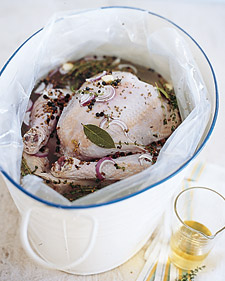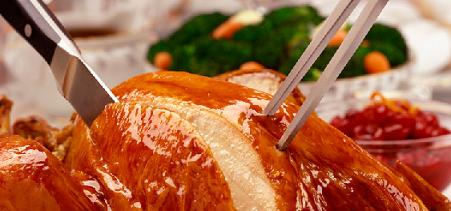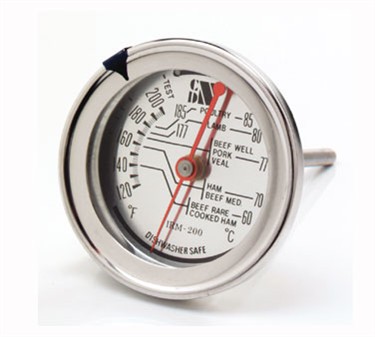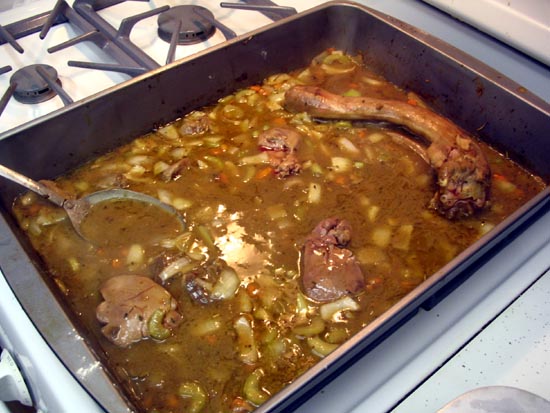
The Perfect Thanksgiving Turkey
Roasting a turkey on Thanksgiving day can either make or break a successful meal. The anticipation of aromas filling the kitchen will usually lead to a table covered with flavors of the holidays and smiling friends and family. Thanksgiving meal is traditionally an all day affair. Most families have recipes that date back to their ancestors, and this is a perfect day for the home cook to "strut their stuff." I have learned many different methods of preparation over the years, and each one is unique in itself. Roasting the perfect turkey can definitely be a challenge, but with the proper tools, practice and patience, we can achieve perfection together!
How big of a turkey should I roast? Most importantly, we need to count the amount of guests we will be serving. A good rule of thumb to go by would be:
 -One (1) pound of raw turkey per person which includes a moderate amount for leftovers.
-One (1) pound of raw turkey per person which includes a moderate amount for leftovers.
- 1 1/2 pounds per person, if you have hearty eaters or want ample leftovers.
- 3/4 pound of whole turkey per person for no leftovers.
To properly thaw the turkey (if frozen of course), I recommend leaving it in a refrigerator for 2 days to slow thaw under a cool temperature. If you are pressed for time, you may place it in a sink or a container in the sink and run cold water over it for a few hours. Once the bird is thawed, you are ready to prepare it for cooking.
 Not every home cook will go the extra mile at home, but I’ve found that brining your turkey can incorporate a great level of flavor and make your turkey extremely moist. I typically brine most poultry and pork before cooking, and have made several different types of flavored brines. A brine by definition is a strong solution of water and salt used for pickling or preserving foods. A sweetener such as sugar or molasses is sometimes added to a brine. I really enjoy molasses and brown sugar, and balance it out with some savory herbs, bay leaves, peppercorns and garlic. Depending on the size of the bird, you can brine a turkey for a few hours, or even let it go overnight. It is very important to remember that the brining solution is high in salt, and you must adjust the amount of salt you use to roast the turkey.
Not every home cook will go the extra mile at home, but I’ve found that brining your turkey can incorporate a great level of flavor and make your turkey extremely moist. I typically brine most poultry and pork before cooking, and have made several different types of flavored brines. A brine by definition is a strong solution of water and salt used for pickling or preserving foods. A sweetener such as sugar or molasses is sometimes added to a brine. I really enjoy molasses and brown sugar, and balance it out with some savory herbs, bay leaves, peppercorns and garlic. Depending on the size of the bird, you can brine a turkey for a few hours, or even let it go overnight. It is very important to remember that the brining solution is high in salt, and you must adjust the amount of salt you use to roast the turkey.
The next step can be a lot of fun, as you get to be very creative with seasoning and preparing your turkey. Seasonings offer a great deal of flavor and can be as simple as salt and black pepper, or as elaborate as Cajun spice or a rub consisting of garlic, chilis and dried herbs. Be sure to rub the entire cavity with your seasoning blend of choice, and always lubricate the outside of the skin with oil or butter so the seasonings will adhere and cook into the bird.
Crisp skin and a moist center is what I typically desire when roasting the perfect turkey, and I have learned a little trick to enhance that outer skin. Carefully lift the skin up around the bird and slide a few pats of softened butter underneath. Generously rub the outer skin with butter and your seasonings, and let them sink in for about an hour before roasting. Many family recipes include stuffing the bird with all kinds of aromatics or even a traditional bread stuffing. It is totally up to you to decide which way you want to go, but stuffing a turkey's cavity can really enhance the flavor of the meat.

If you want to add a little sweetness to the meat, stuff the cavity with some apples and raisins. If you are looking for something more herbaceous, try adding rosemary and thyme with a little garlic and onion. Bread stuffing can be prepared ahead of time and stuffed inside to roast along with the turkey. I like preparing a corn bread stuffing to add a little twist to the meal.
So now that I’m ready to roast, how do I know how long it should cook for, and how high the temperature should be? USDA says that a turkey should not roast under 325 degrees Fahrenheit, so that’s a fair starting point. Approximate cooking times for an unstuffed turkey are as follows: (it is around 20 to 30 mins per pound)
10 - 18 lb bird 3 to 3 ½ hrs
15 – 22 lb bird 3 ½ to 4 hrs
22 – 24 lb bird 4 to 4 ½ hrs
24 – 29 lb bird 4 ½ to 5 hrs
One helpful hint to achieving a nice golden skin, is to start the "searing" process by cooking it in a 400 - 425 degree oven for 10-15 minutes (depending on the size) to start the browning process (sugars begin to caramelize), then lower the temperature to 325 degrees and slow roast for the appropriate time. Basting is another way to impart even browning and to distribute some of those great flavorful juices. You may baste with the juices found in the bottom of the pan, or use some type of fat. Also popular, is to baste with another flavorful liquid, for example a brown stock fortified with apple cider vinegar and herbs. If the bird begins to brown too much, you may cover it with aluminum foil until it has reached doneness, and then finish for the last few minutes uncovered. Be careful not to cover the bird entirely, as you don’t want to steam the turkey.
 How do I know if my bird is done? The USDA recommends that the turkey be cooked to a temperature of 165 degrees as measured in the innermost part of the thigh. If the thigh is 165 degrees, the breast meat is likely to be 10 degrees hotter. Many cooks would tell you that a turkey roasted to those temperatures is overdone and would taste unacceptably dry. Use a meat thermometer to check for doneness, try not to rely on those "pop up timers" that come with most turkeys. You can also prick the leg joint with a fork, and if the juices run just slightly pink or clear, the turkey is done.
How do I know if my bird is done? The USDA recommends that the turkey be cooked to a temperature of 165 degrees as measured in the innermost part of the thigh. If the thigh is 165 degrees, the breast meat is likely to be 10 degrees hotter. Many cooks would tell you that a turkey roasted to those temperatures is overdone and would taste unacceptably dry. Use a meat thermometer to check for doneness, try not to rely on those "pop up timers" that come with most turkeys. You can also prick the leg joint with a fork, and if the juices run just slightly pink or clear, the turkey is done.
To test the accuracy of your instant read thermometer, insert the tip about 2 inches deep into boiling water. At sea level it should register 212 degrees F. If it does not, replace it; or if it has a calibration  device, reset it for accuracy. Nobody wants an overcooked bird, so start checking your bird about 3/4th of the way through the total recommended cooking time.
device, reset it for accuracy. Nobody wants an overcooked bird, so start checking your bird about 3/4th of the way through the total recommended cooking time.
Time to make the gravy! Use the same pan that you roasted this delicious turkey in. The drippings and leftover fat and liquid are going to make this gravy a very tasty one. I like to use a ratio of 1 Tablespoon of fat to 1 Tablespoon of flour to create a "roux" that will thicken my gravy. You can use chicken or turkey stock, or even just deglaze with sherry or white wine and add water. Just be sure to cook out the flour so it doesn’t leave a raw taste to the gravy.

Turkey is done, gravy is ready, and now it's time to roll out all the fix-ins. Cranberry sauce, sweet potato pie, cornbread stuffing, yams, green bean casserole, creamed onions, apple and pecan pie are just some of my favorites! Try something new this year and let me know how it comes out! We all have a lot to be thankful for, and I am very blessed with family and friends who are loving and supporting individuals. God Bless and Happy Thanksgiving. Don’t forget to save me some leftovers!
For now, Good Luck and Good Eating!
~Chef Brian
Gourmet Girl Cranberry Sauce
1 Cup Granulated Sugar
1 Cup Light Brown Sugar
2 Cup Orange Juice
1 Tbl Orange Zest, Chopped
1 tsp Ground Ginger
1/2 each Cinnamon Stick
Method:
Place all ingredients in a saucepot, except the cranberries, and bring to a boil. As soon as it boils, add the cranberries to the liquid. Cook for approximately 5 minutes until all of the cranberries have "popped". Remove the cinnamon stick, and cool. The liquid will be loose and will thicken once it cools.


